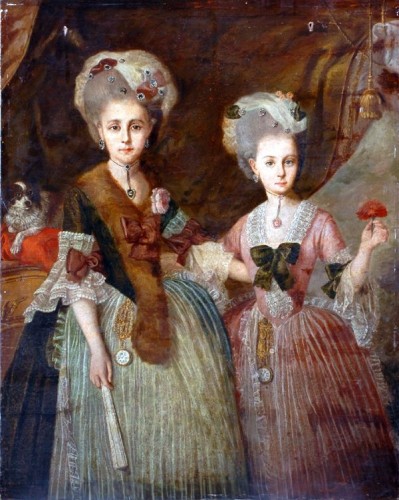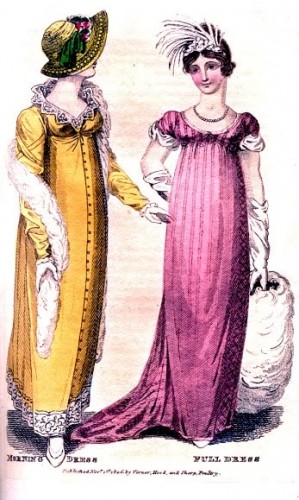To go with our 18th century ‘Rate the Dress‘, this week’s terminology post is 18th century. Our term: bosom friend.
A bosom friend isn’t just the 18th century word for your BFF. It is, literally, a friend for your bosom: a shaped tippet of wool, flannel, or fur, and later a knitted scarf, which kept the chest warm and served as a bust enhancer for less well endowed women.
Bosom friends were worn from the late 18th century till the mid 19th. They were particularly useful with the low necklines and thin muslin dresses at the turn of the century.
A 1789 entry in the Norfolk Chronicle explains the garment:
The fashionable belles have provided themselves with bosom friends for the winter. Their province is to protect that delicate region from assault in every kind; and they may be had at all the furriers shops in town.
Once muslin became the predominant fabric, bosom friends weren’t just for winter use. In 1802 Nancy Woodeford, a country parson’s niece from Norfolk, England, wrote of a friend coming to visit wearing ‘a fur tippet, a bosom friend and a Muff and a Winter Cloke’. And this in July!
The fashionable belles and country matrons of Norfolk may have embraced them, but not everybody approved. A 1796 article published in Philadelphia describes them as pads worn in the bosom as a safeguard against cold weather, and adds that they are ‘scandalous’ and ‘suspicious in appearance’. Oh dear! I think that must be about their double-use as bust enhancers.
Scandalous or not, ‘bosom friends’ were certainly as open to mockery as all fashions. In 1807 a very amusing satirical poem (page 83) was dedicated “to Mrs _____, who had presented the author with a bosom-friend constructed of fur.”
The last description I can find for a bosom friend comes from the 1840 Workwoman’s Guide, which gives complete instructions for a knitted bosom scarf:
Set on your pin seventy stitches, and knit in imitation knitting for about 100 rows, when knit twenty-five stitches for the next row, after which take another pin and fasten off the next twenty stitches, the knit the next twenty-five stitches on another pin.
Continue knitting the twenty-five stitches on one pin in the same stitch, fastening off one stitch at the beginning and the end of each row, next to the middle, which forms the hollowing round the neck . When the stitches are reduced to four fasten off.
Do the same with the other pin containing twenty-five stitches, and fasten off.
Sew white ribbon to the corners to hang it round the neck.
Some persons do not hollow out bosom friends, but knit them square or oblong.
Goodness! I bet that makes perfect sense if you actually know what you are making, but if you don’t it makes none!
I’d be tempted to call my winter scarves ‘bosom friends’ from now on, but it turns out that a modern company has co-opted the other, less warm and cuddly and more provocative, meaning. If you take my meaning!
Unfortunately I was not able to find any images of what was definitely a bosom buddy, so I hope you enjoy my Georgian to Regency winter wear images.
Sources:
Blauvet, J, Avalanche, Anthony, and Glacier, Gregory. Fashion’s Analysis Or The Winter In Town, Part 1: A Satirical Poem, With Notes, Illustrations, Etc. J Osborn, 1807
Buck, Anne. Dress in Eigteenth-Cetury England. B.T. Batsford Ltd: London. 1979
Cumming, Valerie, Cunnington, C. W, and Cunnington,P.E. The Dictionary of Fashion History. Berg Publishers, London. 2010
Schorsch, Anita. Images of Childhood: An Illustrated Social History. Mayflower Books, 1979
The workwoman’s guide, containing instructions in cutting out and completing articles of wearing, 1840.




So fascinating! I love that last picture. So lovely!
Here is a drawing of an 1860’s sontag which I guess is the same thing? (I’ve always heard it called a bosom warmer) http://worldturndupsidedown.blogspot.com/2010/07/civil-war-era-knit-along.html
Genevieve
How interesting. Very similar, but I think a bosom friend is much smaller, doesn’t have the back part, and is meant to be tucked under your garment. But now I must research sontag!
I keep meaning to make myself a sontag. I tie my scarfs in a similar way to keep me warm.
Actually, I think I /do/ more or less understand what they’re getting at in the knitting pattern (although I’m not sure what imitation knitting is!) – the result would be basically a large, simple, knitted bib.
All in all I think I’d rather stick with the guimpe.
Oh my! How very…attractive!
Thanks for the pattern…I will have to try it some day!
Oooh! Please share if you do! I’d love to see how it turns out!
After much web site searching trying to come up with a definition of “imitation knitting” I have a theory. (I could come up with no definate answers…only a theory.) Most of the knitting done in the 1840 would have been done in a circular or tubular fashion using 4 needles (socks, mitts, hats…) They did that so there would be no lumpy seams and they wouldn’t have to go back a forth between knit rows and purl rows. The bosom friend would have been a flat one layer thing…not a tube. So to “imitate” the look these folks would have been used to when looking at mitts and socks, they would have had to knit a row and purl a row. My theory is the imitation knitting is what we would now call the stocking stitch. Any experts out there got a better explanation? I intend to make the thing some day and would like to make it correctly!
Hey, I actually drew a picture of what this should look like:
http://worldturndupsidedown.blogspot.com/2010/09/civil-war-sontag-update.html
Dawn, that’s a fascinating theory, and I suppose it makes sense. But weren’t they knitting shawls and things, flat, by the 1840s? I’d have to check.
Apart from the mystery of “imitation knitting”, the pattern is actually quite clear. I think I would be one of those to knit my bosom friend “square or oblong”, however, as I think as written this would look like a bib!
Good point. Some of those terms can be a pain in the butt trying to figure out. I guess we have to assume that there were some creative folks out there that would have thought “hmmm, imitation knitting would be nice but what if I used this pattern instead?” and used the stitch count and increases and decreases as a foundation but did their own thing for the rest. That would make any attempts on our 21rst century parts “creatively authentic”.
As for the bib shape….I think that since it’s intension was to be worn under clothes it’s shape is irrelevant. Only the part at the neck line would be showing. The important part of the shape would be if it was large enough to cover the bosom and the bare part of the neck line and that the back would not be so bulky as to give the appearance of back boobs. Women have been stuffing their bras with socks for as long as there have been bras. No one worried how the socks looked lol.
Dawn, “imitation knitting” in this pattern means “imitation double knitting” as is stated in the pattern immediately before this one.
Imitation Double Knitting is:
Row 1: p1 k1 p1 k1
Row 2: p1 k1 p1 k1
Lots of things then were knitted flat, some things were even knitted flat and sewn up into tubes. So your stitch was right. I’d love to see this if you end up knitting it!
Thanks so much for that clear up, Stephanie Ann. I came across that idea while doing my search but wasn’t sold on it. I started thinking the imitation knit and the imitation double knit were two different things because in modern knitting, terms like that implied the stitches were similar but not completely. But now in retrospect it makes sense. (more sense than my idea of the stocking stitch). It would create a waffle pattern that would both be warm and add bulk to the bosom. Also, as both sides would look the same, the wearer would not have to think about what was the inside and the outside. I think in modern terms that is called the moss stitch.
I will make the thing…I actually had to fight the urge to start it last night as I have a billion projects started…one of which needs to be wearable by Saturday! And I don’t have an outfit to wear it with. This will start those wheels in my head turning (now I need to plan an 1840’s outfit….) I should go out and buy some real wool in natural shades. I’m thinking they didn’t have varagated wool made out of synthetic fibers in the 1840’s! And finally, I need to decide if I’d actually make it in those dimensions. I’m busty so I doubt that will cover my bosoms. But since I don’t need enhancement I may not want something that covers my bosoms…..
Thank you! It’s fantastic how much knowledge and information is out there 🙂
I’m really wondering how closely the fur or fabric 18th century bosom-friends resembled the mid-19th century version now. It’s such a pity there are so few images, and no extent ones that I have been able to identify,
That sounds like seed stitch….. is it the same thing? What an interesting notion.
Ava, In a seed stitch, you alternate the next row so that there is a purl where a knit stitch was previously. I love the look of seed stitch, though. Has anyone come across seed stitch in historical patterns?
So it would be more of a 1×1 rib?